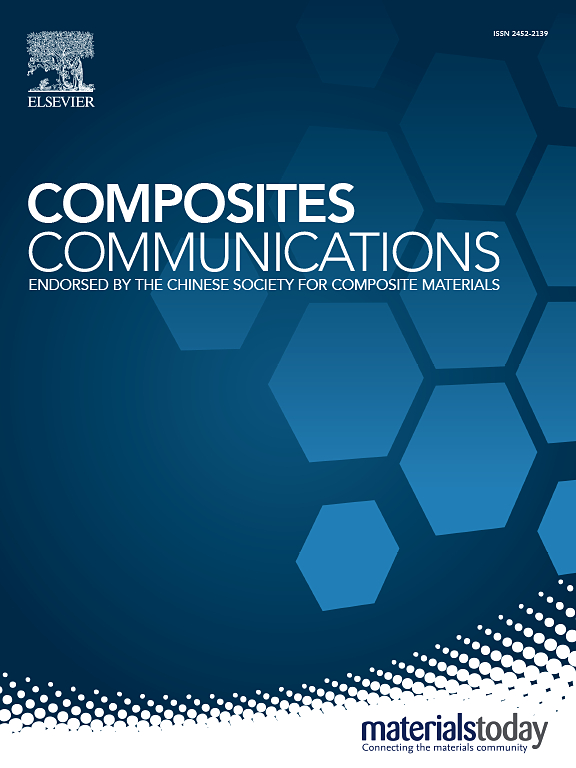Influence of sizing concentration on strength, stiffness, and porosity in textile grade carbon fiber (TCF)-Epoxy composites: Revealing inverse trends
IF 6.5
2区 材料科学
Q1 MATERIALS SCIENCE, COMPOSITES
引用次数: 0
Abstract
The effect of fiber sizing (i.e., surface treatment) concentration (0 %, 1.36 %, 1.52 %, 1.94 %, and 2.13 %) on the mechanical properties (tensile, flexural, interlaminar shear strength (ILSS), and low velocity impact) of textile grade carbon fiber (TCF)-epoxy composite is examined. An inverse relationship between the strength and stiffness of the composite is observed with increased sizing concentration. The root mean square (RMS) roughness of the fiber surface increased from 17.8 nm (unsized) to 22.7 nm with 2.13 % sizing concentration. It was found that the tensile strength increased by 131 % from 221.4 ± 18.5 MPa (unsized) to 510.8 ± 28.05 MPa (for 1.36 % sizing) and further by 155 %–563.7 ± 14.95 MPa at 2.13 % sizing. On the contrary, the stiffness is initially increased by 126 % from 33.52 ± 7.80 GPa (unsized) to 75.9 ± 3.21 GPa (for 1.36 % sizing) but reduced with further increase in the sizing concentration. A single fiber pull-out test is simulated using the finite element method to validate the reverse trend in strength and stiffness. The varying sizing concentration is simulated by introducing an interface of varying thickness between fibers and matrix. Simulation results confirm that a thicker interface, corresponding to a higher sizing concentration, decreases interfacial shear stress, enhancing material strength while decreasing stiffness. The reverse trend in strength and stiffness with the sizing concentration aligns with experimental observations. The present study emphasizes the importance of sizing concentration for mechanical properties and provide a design criterion for customized high-strength and high-stiffness applications.
研究了纤维施胶(即表面处理)浓度(0 %、1.36 %、1.52 %、1.94 % 和 2.13 %)对纺织级碳纤维(TCF)-环氧树脂复合材料机械性能(拉伸、弯曲、层间剪切强度(ILSS)和低速冲击)的影响。随着施胶浓度的增加,复合材料的强度和刚度之间出现了反比关系。施胶浓度为 2.13 % 时,纤维表面的均方根粗糙度从 17.8 nm(未施胶)增加到 22.7 nm。研究发现,拉伸强度增加了 131%,从 221.4 ± 18.5 兆帕(未施胶)增加到 510.8 ± 28.05 兆帕(施胶浓度为 1.36%),施胶浓度为 2.13%时,拉伸强度进一步增加了 155%-563.7 ± 14.95 兆帕。相反,刚度最初增加了 126%,从 33.52 ± 7.80 GPa(未施胶)增加到 75.9 ± 3.21 GPa(施胶浓度为 1.36%),但随着施胶浓度的进一步增加而降低。使用有限元方法模拟了单根纤维的拉出试验,以验证强度和刚度的反向趋势。通过在纤维和基体之间引入不同厚度的界面来模拟上浆浓度的变化。模拟结果证实,界面越厚,施胶浓度越高,界面剪切应力越小,材料强度越高,而刚度越小。强度和刚度随施胶浓度变化的反向趋势与实验观察结果一致。本研究强调了施胶浓度对机械性能的重要性,并为定制的高强度和高刚度应用提供了设计标准。
本文章由计算机程序翻译,如有差异,请以英文原文为准。
求助全文
约1分钟内获得全文
求助全文
来源期刊

Composites Communications
Materials Science-Ceramics and Composites
CiteScore
12.10
自引率
10.00%
发文量
340
审稿时长
36 days
期刊介绍:
Composites Communications (Compos. Commun.) is a peer-reviewed journal publishing short communications and letters on the latest advances in composites science and technology. With a rapid review and publication process, its goal is to disseminate new knowledge promptly within the composites community. The journal welcomes manuscripts presenting creative concepts and new findings in design, state-of-the-art approaches in processing, synthesis, characterization, and mechanics modeling. In addition to traditional fiber-/particulate-reinforced engineering composites, it encourages submissions on composites with exceptional physical, mechanical, and fracture properties, as well as those with unique functions and significant application potential. This includes biomimetic and bio-inspired composites for biomedical applications, functional nano-composites for thermal management and energy applications, and composites designed for extreme service environments.
 求助内容:
求助内容: 应助结果提醒方式:
应助结果提醒方式:


